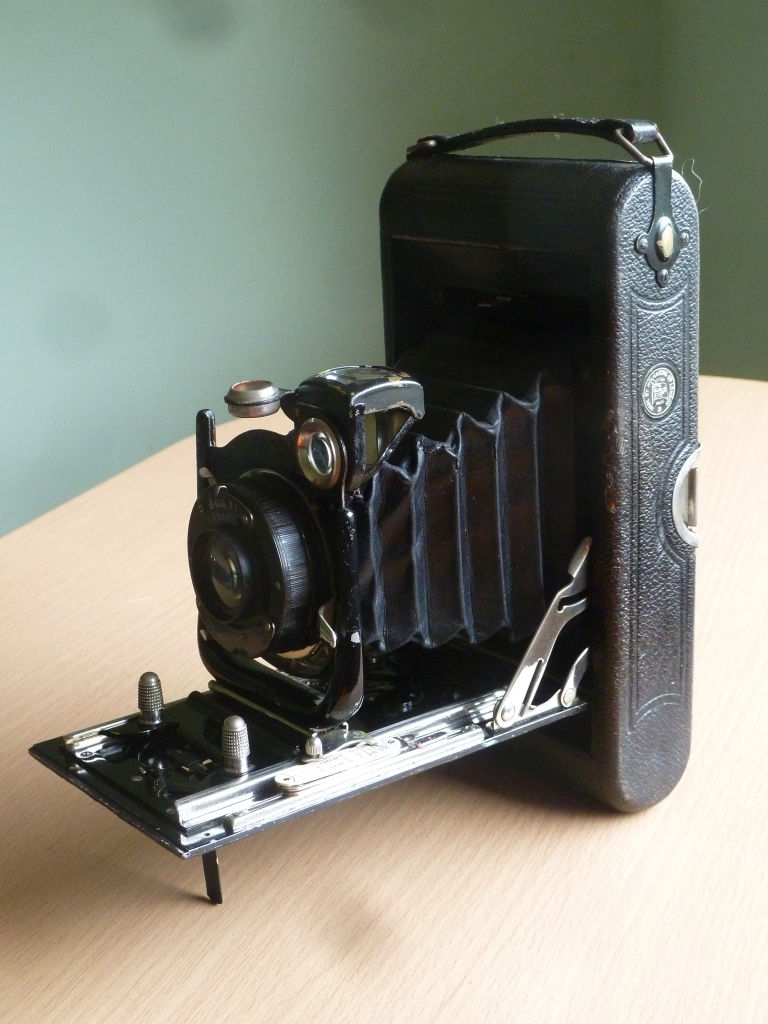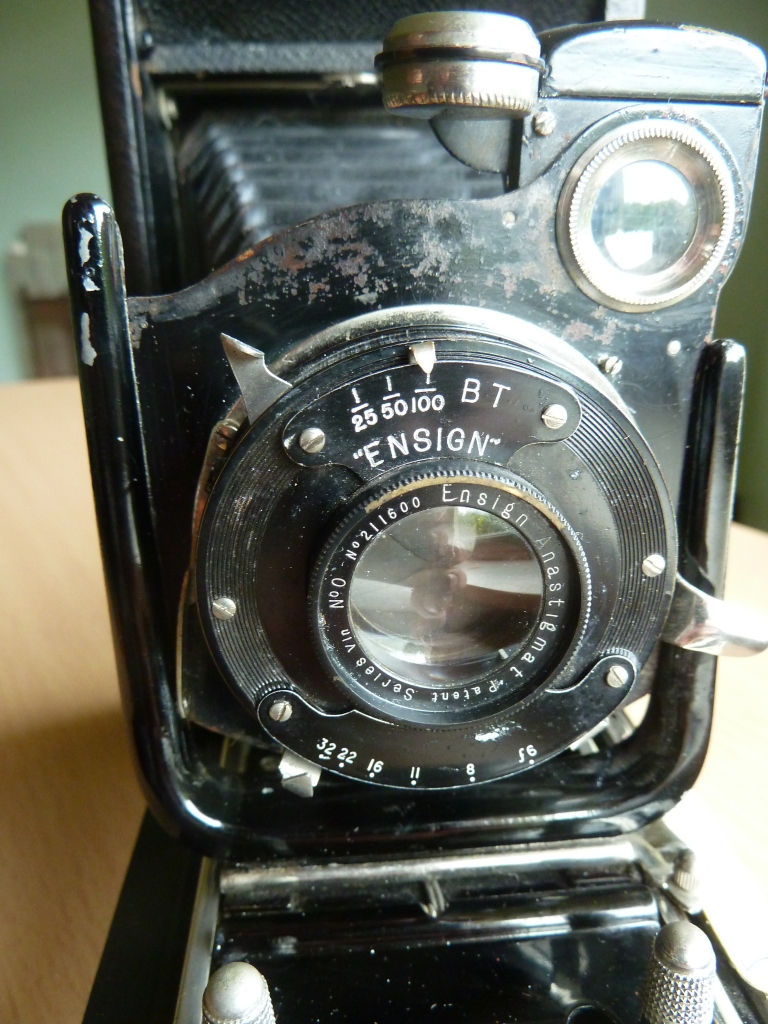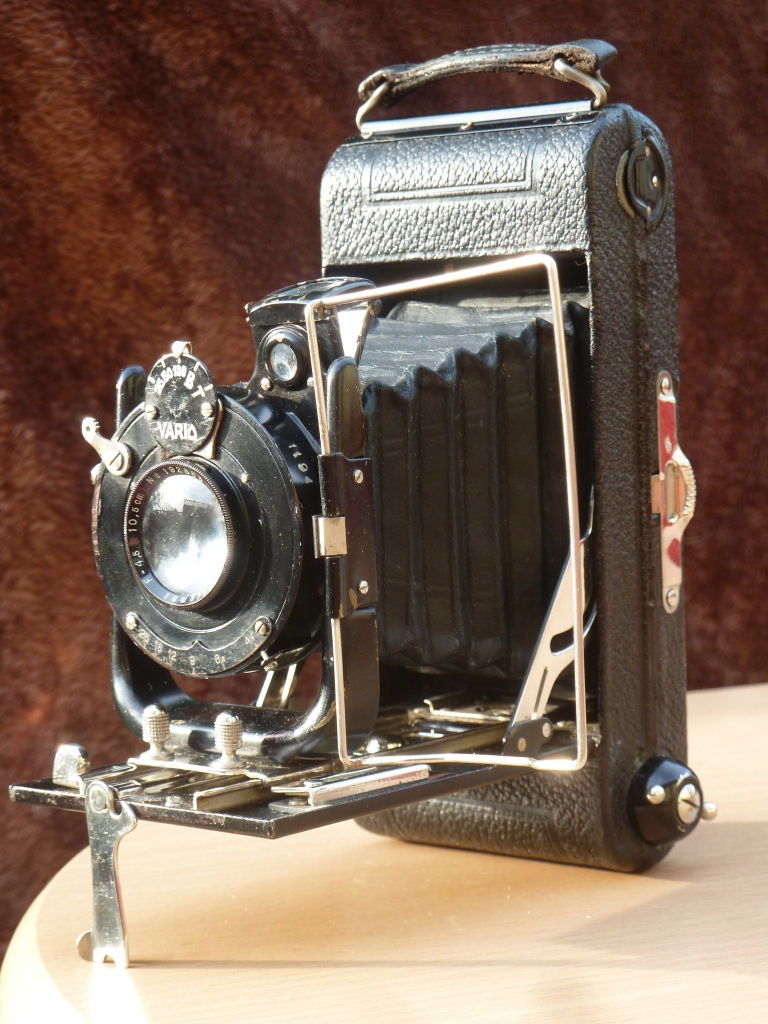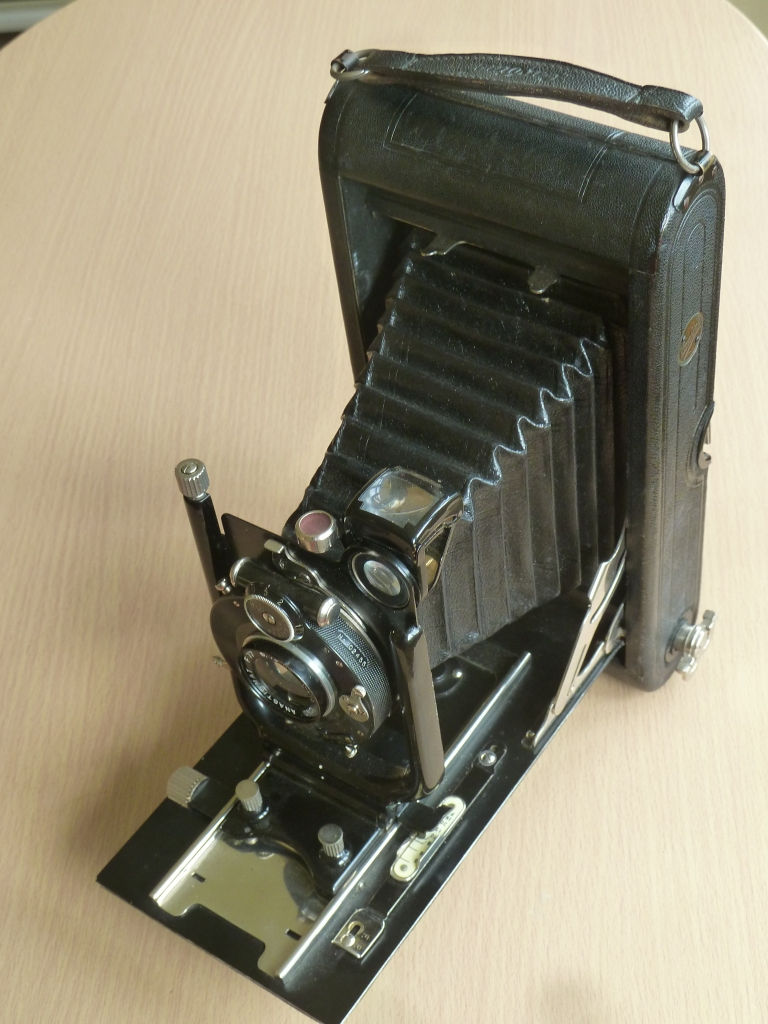The ''Ensign'' 3 1/4 x 4 1/4 Folder with plate and film pack capabilities.
- Kamera Ostalgie

- Aug 25
- 6 min read
Updated: Sep 20

After the recent post on a Carbine with the interesting feature of being able to be used for plates or a film pack as well as roll film, I thought we could have a quick look at Houghton's and their Ensign version of the same idea.

It seems to have been a popular option at one time, making a camera designed primarily for roll film, being able to take other formats such as glass plates and film packs. I suppose it makes sense really, plates were very popular, the public were used to plates, roll film being new and unfamiliar, and there was much more choice of speeds and emulsions with plates at that time. So a camera that could use film, but also film packs and plates was a much more versatile piece of kit. Promoting this feature at the time, Houghtons pointed out it was useful for if you just needed to take one picture and get it developed right away.

So lets have a quick general look at the camera to start with. This Houghtons Ensign was I suppose typical of its time, there were many companies producing this style of roll film camera, mostly of German origin. The ''Ensign'' though was an entirely British affair. Houghtons had built a very modern camera factory in 1920, designed by the famous industrial Art Deco architects Wallis, Gilbert & Partners and it sat on Fulbourne Road in Walthamstow, it was claimed at the time to be the biggest camera factory in the British Empire and certainly looked the part. The camera above would have started its life in London either at Houghtons first factory in High Holborn or more likely this new purpose built one in Walthamstow, pictured below.

The ''Ensign'' had an Ilex shutter with speeds of 1/25th, 1/50th, 1/100th of a second as well as Bulb and Time. (B and T)
The lens is an Ensign Anastigmat, marked as Patent Series VIn No,0. The lens number is 211600. The apertures are f6, f8, f11, f16, f22 and a tiny f32, looks like the sun always shone brightly in 1920's Walthamstow! There is no focal length stated on the lens.
Focusing of the camera was done by moving the lens panel on its base, there was a nice ivory coloured panel to guide you, and infinity was located with a nice click stop.

The focus guide, in red metres, in black good old feet. Which is nice, as I still think in feet and yards, not those foreign meter things! Yep, I know, but I'm getting old !

Now just to remind the early 20's photographer, is this really useful reminder telling him or her, to change their focus scale to F if using film, or P if the photographer was using glass plates. Why? Well this neat ''Ensign'' compensated for the different thickness of either film or plates, so your image would be nice and sharp. You did this by locking the hook shaped catch in at F when using film (in red) or at P, also in red if you were using your glass plates ! Simple !

Lets have a look at the business end of this multi use camera. If you were using roll film then you would look for your number one appearing at the little red window, take your picture then wind on until the number 2 appeared. The wind on lever is on a ratchet and could only be wound one way, the right one ! Your film in its wooden spool would be pulled over onto the wooden take up spool, all you had to do was look for the next number in the red widow.

If you were using plates you would have to slide out the panel on the camera back by firstly swinging open the catch shown above, before you could insert your ground glass and plate holder.

The central panel shown above could then be carefully slid out.

The central blanking plate could then be removed.

And your plate holder with ground glass screen would be slid into the groves where the back panel had been. There would be a folding hood on the plate holder, you would fold out the hood to give the ground glass some shade and compose and focus your picture on the ground glass.
Unfortunately, at present I don't have a ground glass holder and hood but if you want to know what they would have looked like then go to this Flickr link below and it is all there!
If you look here on Dustin McAmeras great photographs on Flickr then they will give you a better picture of what I'm trying to describe!
I wonder what the chances are of finding the plate holder and film pack adaptor today? I will be looking !
The best part of doing this blog is the extra help and information that comes from some of the subscribers to Kamera Ostalgie about the cameras that I have posted on. Even now as a write this post, I'm getting links, pictures and information that I did not have regarding the camera I'm currently writing about! How good is that !

Houghtons thoughtfully put a sticker on the camera back telling the user that the film to use in this camera is Ensign 3 1/4 Roll Film. My subscribers told me instantly that this films Kodak equivalent was Kodak 118 film. Which gave me the image size of 3 1/4 x 4 1/4, and alternative period film makers films.
So you could use Kodak 118, Ensign E18, Butchers B18, Ilford 18, Illingworths 12, Agfa E, Zeiss E, and Ansco 7A, of course there will be others, but the above would have been the films that were readily available at the time.

I'm still not sure what exact model this camera is, or exactly when it was made. I have spent hours searching the internet, as have some of the Kamera Ostalgie subscribers. We have got near, but not exact ! So we have narrowed it down to after WWI, as the film stickers and logo's were slightly different, but by 1930 the plate back feature was on its way out of the Ensign range, except maybe for the Ensign No7 which seemed to hang on to this feature. So it looks like it was manufactured somewhere in the 1920's, my gut feeling is 1920 to 1925, as for what model, well it looks like it could be the forerunner of the Number 3 Ensign, but at this stage it seems that they did not have numbers, there is no number on this camera, just the name ''Ensign''.
I'm sure one of the blogs readers will be able to put me right about year and model! I hope so!

To finish off, I bought this particular camera at Hartleys Auctioneers in Ilkley West Yorkshire, about 25 years ago, It was a bit on the rough side, incredibly dirty and jammed half open. I got it home put it safely away in a box to sort out later. Later was this week ! 25years later! Anyway I set to, managed to unjam the runners and gave it a good clean up, it took the best part of two days to do it, God it was dirty ! Anyway, I'm glad that I bothered, it's turned out to be a very interesting camera. The Illex shutter worked on all speeds right away, needing no attention whatsoever. That is some shutter!

The leather covering has come up really well, it is a quality leather with nice graining and tooling patterns.

So, there we have it, The ''Ensign'' Roll film camera for Ensign 3 1/4 film (118) with a plate / film pack back, produced in the 1920's at Ensigns state of the art new factory in Fulbourne Road, Walthamstow, East London England.
It is amazing what you end up finding out, three days ago I knew nothing at all about this folder, but with a lot of research and help from others I have found out quite a bit. The trouble is these Ensign cameras are getting too interesting, so expect more from me on this subject in the future!
It is a pity Houghton's factory did not survive too. Nobody looks back and thinks in this crazy modern world, if they had, then the factory, a masterpiece from the team of Wallis, Gilbert & Partners’ the firm that gave us such iconic Art Deco industrial buildings as the Hoover Building and the Firestone Factory might well have survived. Sadly it was demolished not that long ago. Luckily we still have some of the fantastic cameras that Houghtons produced in it.
I hope you enjoyed this post and it gave you something interesting to read this Bank Holiday!
Take care,
Phil



